
Copernicus is a lunar impact crater located in eastern Oceanus Procellarum. It was named after the astronomer Nicolaus Copernicus. It typifies craters that formed during the Copernican period in that it has a prominent ray system. It may have been created by debris from the breakup of the parent body of asteroid 495 Eulalia 800 million years ago.

Ångström is a small lunar impact crater located on the border between Oceanus Procellarum to the west and Mare Imbrium to the east. To the south is a formation of mountains rising out of the mare named the Montes Harbinger. To the east are some wrinkle ridges named the Dorsum Bucher and Dorsa Argand. This crater is bowl-shaped, with a circular rim and inner walls that slope down to the small central floor. It has a higher albedo than the surrounding maria. The crater halo is radar dark, indicating a lack of larger blocks among the fine ejecta.

Beer is a relatively small lunar impact crater located on the Mare Imbrium, to the east of the crater Timocharis. It was named after German astronomer Wilhelm W. Beer. Just to the northwest is the matching twin Feuillée.
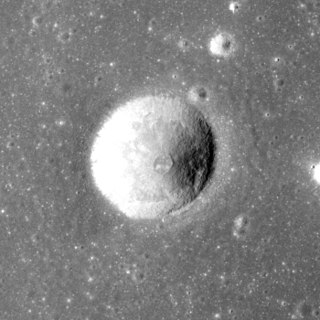
Borel is a tiny lunar impact crater located in the southeast part of Mare Serenitatis. It was named after French mathematician Émile Borel. To the northeast is the crater Le Monnier and to the southeast is the crater Abetti. Borel was previously identified as Le Monnier C.
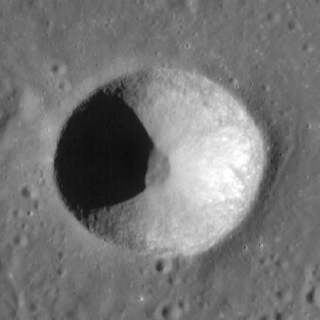
Biot is a small, bowl-shaped lunar impact crater located in the southern reaches of the Mare Fecunditatis. It is named after French astronomer Jean-Baptiste Biot."Biot (crater)". Gazetteer of Planetary Nomenclature. USGS Astrogeology Research Program. It is a circular formation with a sharp-edged rim that has not been significantly worn. The inner walls slope down to a relatively small interior floor. The albedo of the wide inner walls is higher than the surrounding lunar mare, giving it a light hue. To the southeast is the crater Wrottesley.

Bruce is a small lunar impact crater located in the small lunar mare Sinus Medii. It lies to the west-northwest of the irregular crater Rhaeticus, and is about 33 km to the west of the even smaller Blagg. It is named for Catherine Wolfe Bruce, an American philanthropist and patroness of astronomy.

Cauchy is a small lunar impact crater on the eastern Mare Tranquillitatis. It was named after French mathematician Augustin-Louis Cauchy. It is circular and symmetric, with a small interior floor at the midpoint of the sloping inner walls. Due to the high albedo of this bowl-shaped formation, it is particularly prominent at full Moon.
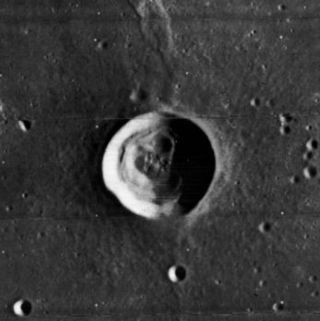
C. Herschel is a small lunar impact crater that lies on the western part of Mare Imbrium. It is named after German astronomer Caroline Herschel. It is a circular, bowl-shaped formation that has not undergone significant erosion. The interior floor has the same low albedo as the surrounding lunar mare. To the south-southwest is the similar crater Heis. C. Herschel lies on a wrinkle ridge of the lunar mare named the Dorsum Heim.

Milichius is a bowl-shaped lunar impact crater that is located in the northern part of the Mare Insularum. To the southeast is the slightly larger Hortensius, a similar formation.

Gambart is a small lunar impact crater on the Mare Insularum, near the central region of the Moon. It is named after French astronomer Jean-Félix Adolphe Gambart. It can be located to the south-southeast of the prominent ray crater Copernicus. In the past, the floor of Gambart has been flooded with lava, leaving a relatively flat surface surrounded by a smooth but somewhat polygon-shaped outer rim. To the southwest of Gambart is an area of hilly terrain deposited from ejecta during the Mare Imbrium impact, known as the Fra Mauro Formation.

Lassell is a small lunar impact crater that is located in the eastern part of the Mare Nubium. It was named after British astronomer William Lassell. It lies to the west of the crater Alpetragius and southwest of Alphonsus.
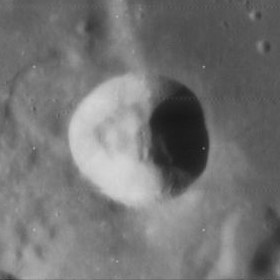
Bellot is a small lunar impact crater that is located on the southwest edge of Mare Fecunditatis. It lies between the craters Goclenius to the northwest and Crozier to the southeast. To the southwest is Colombo, and to the west is Magelhaens.

Sinas is a small lunar impact crater that lies in the eastern part of the Moon on the Mare Tranquillitatis. Its diameter is 12 km. It was named after the Greek magnate Simon Sinas. This is an isolated formation that is located very near the midpoint of the lunar mare. Sinas is circular and bowl-shaped, with a small floor at the midpoint. A wrinkle ridge intersects the east edge of the crater, and several lunar domes lie to the north.

Cayley is a small lunar impact crater that is located in a lava-flooded region to the west of Mare Tranquillitatis. It was named after the 19th-century English mathematician Arthur Cayley. It lies to the northwest of the smaller crater De Morgan and the larger D'Arrest. West and slightly north of Cayley is Whewell, a crater of about the same dimensions. To the north is a linear rille designated Rima Ariadaeus, which follows a course to the east-southeast.
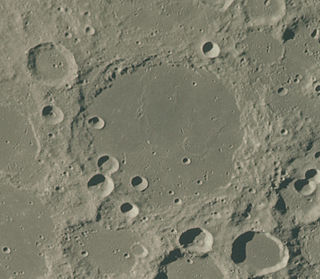
Lyot is a large lunar impact crater that is located along the southeastern limb of the Moon. It lies within the irregular and patchy lunar mare named Mare Australe, and to the south of the crater Hamilton. Due to its location, this formation is viewed at a low angle from the Earth, and its visibility is affected by libration.

Peirce is a small lunar impact crater in the western part of Mare Crisium. That dark, circular lunar mare is located in the east-northeasterly part of the Moon's near side. It was named after the American mathematician Benjamin Peirce. Peirce lies to the north of the craters Yerkes and Picard, and southeast of Macrobius located outside the mare. Just over a crater diameter to the north of Peirce is the smaller Swift. To the northwest is the wrinkle ridge Dorsum Oppel.

T. Mayer, or Tobias Mayer, is a lunar impact crater that is located at the western end of the Montes Carpatus mountain range along the southern edge of Mare Imbrium. It was named after German astronomer Tobias Mayer. To the west is the Oceanus Procellarum, and to the south is Mare Insularum. The crater is located a couple of hundred kilometers to the northwest of the prominent crater Copernicus.

Dunthorne is a small lunar impact crater that is located to the northwest of the small lunar mare called Palus Epidemiarum, in the southwest part of the Moon's near side. It was named after British astronomer Richard Dunthorne. It lies to the southwest of the crater Campanus, east of Vitello. Due south is Ramsden.

Kunowsky is a small lunar impact crater on the Mare Insularum, in the western half of the Moon's near side. It is named after the German astronomer Georg Karl Friedrich Kunowsky. It lies about one third the distance from Encke to the west-northwest and Lansberg to the east-southeast.

Nichollet is a small, isolated lunar impact crater on the Mare Nubium, a lunar mare in the southwest quadrant of the Moon. It was named after French astronomer Joseph Nicollet. This crater is located to the north of the crater Pitatus, about midway between Wolf to the west and Birt to the east.

























